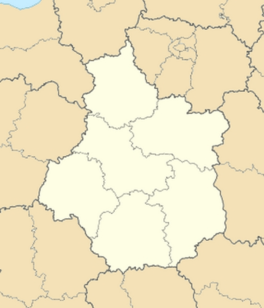Avaray
| Avaray | ||
|---|---|---|
| ||
 Avaray | ||
|
Location within Centre-Val de Loire region  Avaray | ||
| Coordinates: 47°43′24″N 1°33′55″E / 47.7233°N 1.5653°ECoordinates: 47°43′24″N 1°33′55″E / 47.7233°N 1.5653°E | ||
| Country | France | |
| Region | Centre-Val de Loire | |
| Department | Loir-et-Cher | |
| Arrondissement | Blois | |
| Canton | Mer | |
| Intercommunality | Beauce Val de Loire | |
| Government | ||
| • Mayor (2014–2020) | Jean-François Mézille | |
| Area1 | 13.88 km2 (5.36 sq mi) | |
| Population (2013)2 | 728 | |
| • Density | 52/km2 (140/sq mi) | |
| Time zone | CET (UTC+1) | |
| • Summer (DST) | CEST (UTC+2) | |
| INSEE/Postal code | 41008 / 41500 | |
| Elevation |
75–118 m (246–387 ft) (avg. 106 m or 348 ft) | |
|
1 French Land Register data, which excludes lakes, ponds, glaciers > 1 km² (0.386 sq mi or 247 acres) and river estuaries. 2 Population without double counting: residents of multiple communes (e.g., students and military personnel) only counted once. | ||
Avaray is a commune in the Loir-et-Cher department in central France.
History
Avaray is a French territorial title belonging to a family some of whose members have been conspicuous in history. The Béarnaise family named Besiade moved into the province of Orléanais in the 17th century, and there acquired the estate of Avaray. In 1667 Theophile de Besiade, marquis d'Avaray, obtained the office of grand bailiff of Orleans, which was held by several of his descendants after him.[1]
Claude Antoine de Besiade, marquis d'Avaray, was deputy for the bailliage of Orleans in the states-general of 1789, and proposed a Declaration of the Duties of Man as a pendant to the Declaration of the Rights of Man; he subsequently became a lieutenant-general in 1814, a peer of France in 1815, and duc d'Avaray in 1818. Antoine Louis Francois de Besiade, comte d'Avaray, son of the above, distinguished himself during the Revolution by his devotion to the comte de Provence, afterwards Louis XVIII, whose emigration he assisted. Having nominally become king in 1799, that prince created the estate of Ile-Jourdain a duchy, under the title of Avaray, in favour of the comte d'Avaray, whom he termed his "liberator".[1]
Population
| Historical population | ||
|---|---|---|
| Year | Pop. | ±% |
| 1793 | 709 | — |
| 1800 | 760 | +7.2% |
| 1806 | 748 | −1.6% |
| 1821 | 836 | +11.8% |
| 1831 | 865 | +3.5% |
| 1836 | 922 | +6.6% |
| 1841 | 917 | −0.5% |
| 1846 | 942 | +2.7% |
| 1851 | 965 | +2.4% |
| 1856 | 892 | −7.6% |
| 1861 | 851 | −4.6% |
| 1866 | 903 | +6.1% |
| 1872 | 863 | −4.4% |
| 1876 | 823 | −4.6% |
| 1881 | 813 | −1.2% |
| 1886 | 807 | −0.7% |
| 1891 | 706 | −12.5% |
| 1896 | 659 | −6.7% |
| 1901 | 622 | −5.6% |
| 1906 | 606 | −2.6% |
| 1911 | 579 | −4.5% |
| 1921 | 509 | −12.1% |
| 1926 | 458 | −10.0% |
| 1931 | 480 | +4.8% |
| 1936 | 423 | −11.9% |
| 1946 | 385 | −9.0% |
| 1954 | 394 | +2.3% |
| 1962 | 397 | +0.8% |
| 1968 | 491 | +23.7% |
| 1975 | 466 | −5.1% |
| 1982 | 481 | +3.2% |
| 1990 | 514 | +6.9% |
| 1999 | 577 | +12.3% |
| 2006 | 708 | +22.7% |
| 2009 | 730 | +3.1% |
Sights
The Château d'Avaray was built in the 16th century; of this building only four corner towers remain. In the 1730s a central building with two curving wings was erected. The park is magnificent and is said to have been designed by Le Nôtre.[2]
See also
References
- 1 2 Prinet 1911, p. 51.
- ↑ Châteaux of the Loire. (Nagel Travel Guide Series.) Geneva: Nagel; p. 45
- Attribution
 This article incorporates text from a publication now in the public domain: Prinet, Léon Jacques Maxime (1911). "Avaray". In Chisholm, Hugh. Encyclopædia Britannica. 3 (11th ed.). Cambridge University Press. p. 51.
This article incorporates text from a publication now in the public domain: Prinet, Léon Jacques Maxime (1911). "Avaray". In Chisholm, Hugh. Encyclopædia Britannica. 3 (11th ed.). Cambridge University Press. p. 51.
| Wikimedia Commons has media related to Avaray. |
